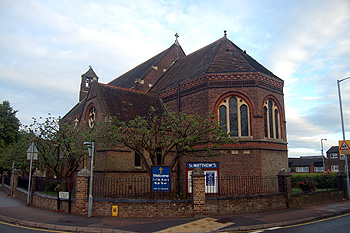The Creation of Saint Matthews High Town

Saint Matthew's church from the south-east June 2011
Former County Archivist Chris Pickford wrote a history of Bedfordshire churches in the 19th century spanning four Bedfordshire Historical Record Society volumes. This article is taken from his entry for Saint Matthew’s in Volume 80, published in 2001.
HighTown developed quickly in the middle of the 19th century. By 1869 nearly a quarter of Luton’s population of 20,000 lived in the HighTown area. This area was well served by nonconformist meetings, such as the Primitive Methodist church in High Town Road, but had no Anglican church. So in that year the Vicar of Saint Mary’s, James O’Neill, announced the intention to build a church in HighTown.
The ecclesiastical district was formed in 1872 and in the following year a temporary wooden church was bought from Woburn and put up in Brunswick Street. This new church was complemented by a new school and a new parsonage at 85 Wenlock Street (1875-1876). This wooden building also served as the Sunday schoolroom. This was the fifth new Anglican church in Luton after Christchurch which opened in 1857, Stopsley (1860), Albert Road (1861) and Biscot (1866).
The present church was designed by G. Vialls and J. R. Brown. Its foundation stone was laid by the Duchess of Bedford on 28th September 1875. The church was consecrated on 12th December 1876 [P132/1/1] and on 20th March 1877 Luton, Saint Matthew became a separate ecclesiastical parish [P132/5/1].
The church is brick built and stands on the corners of Havelock Road with both Wenlock Street and Boyle Street. It was known locally as “The Cathedral of High Town”. In his Buildings of England series for Bedfordshire, however, Professor Nikolaus Pevsner describes it as “dignified but dull”. When originally built the church was very short of money and so was very sparsely furnished.